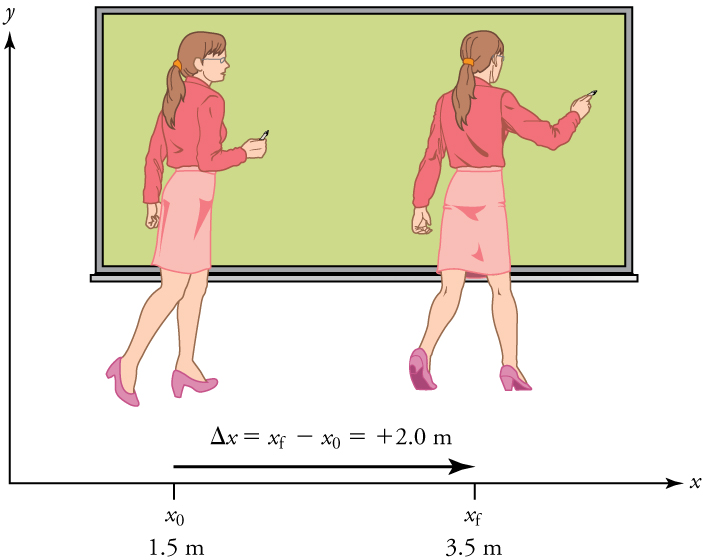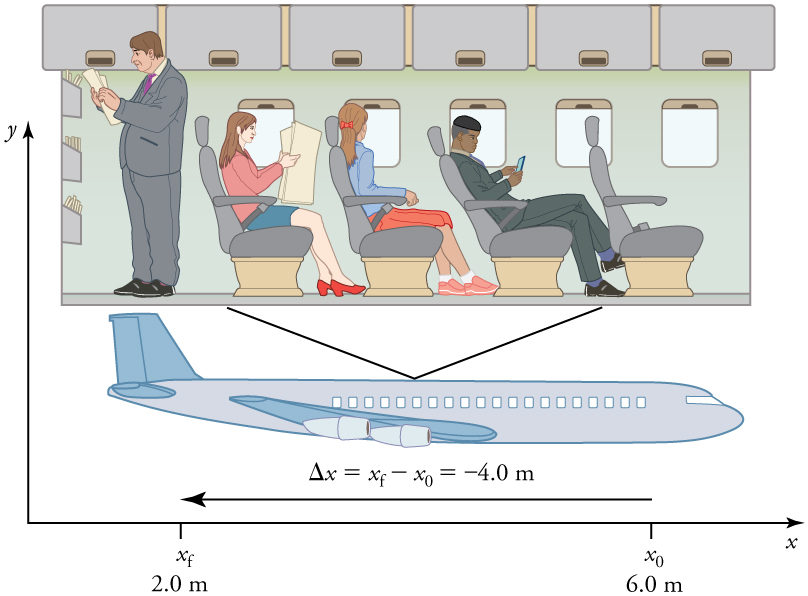[OpenStax College physics 2e: Kinematics] One-dimensional motion: Basic concepts
 Displacement
Displacement
If an object moves relative to a reference frame (for example, if a professor moves to the right relative to a whiteboard or a passenger moves toward the rear of an airplane), then the object’s position changes. This change in position is known as displacement. The word “displacement” implies that an object has moved or has been displaced. We define the concept below.
#\textbf{Displacement}# is the change in position of an object:
\[\begin{array}{rcl}\blue{\Delta x}&=&\green{{x}_f}-\orange{{x}_{0}}\end{array}\]where #\blue{\Delta x}# is displacement, #\green{{x}_f}# is the #\textbf{final position}#, and #\orange{{x}_{0}}# is the #\textbf{initial position}#.
Let us look at an example.

In the example displayed above, the professor’s initial position is #\orange{{x}_{0}}=\orange{\unit{1.5}{m}}# and her final position is #\green{{x}_f}=\green{\unit{3.5}{m}}#. Thus her displacement is
\[ \begin{array}{rcl}\blue{\Delta x}=\green{{x}_f}-\orange{{x}_{0}}=\green{3.5}-\orange{1.5 }=\blue{\unit{+2.0}{ m}}\end{array}\]In this coordinate system, motion to the right is positive, whereas motion to the left is negative. As we will see below, a choice of positive direction must always be made.
Displacement has a direction as well as a magnitude. Below, we discuss how to find this direction.
In one-dimensional motion, direction can be specified with a plus or minus sign. When you begin a problem, you should select which direction is positive (usually, that will be to the right or up, but you are free to select positive as being any direction).
Values on the direction you have selected as positive are either written as they are or with a plus sign, e.g., in the example above the initial position, #\orange{x_0}#, can either be written as #\orange{x_0}=\orange{\unit{1.5 }{m}}# or #\orange{x_0}=\orange{\unit{+1.5 }{m}}#. Values on the direction you have selected as negative are always preceded by a minus sign.
Let us look at another example.

In the example displayed above, the airplane passenger’s initial position is #\orange{{x}_{0}}=\orange{\unit{6.0}{ m}}# and his final position is #\green{{x}_f}=\green{\unit{2.0}{m}}#, so his displacement is
\[ \begin{array}{rcl}\blue{\Delta x}=\green{{x}_f}-\orange{{x}_{0}}=\green{2.0}-\orange{6.0}=\blue{\unit{-4.0}{ m}}\end{array} \]His displacement is negative because his motion is toward the rear of the plane, or in the negative #x# direction in our coordinate system.
Although displacement is described in terms of direction, distance, which we define next, is not.
The distance is defined to be the magnitude or size of displacement between two positions.
Note that the distance between two positions is not the same as the distance traveled between them. Distance traveled is the total length of the path traveled between two positions.
Distance has no direction and, thus, no sign. In the second example shown above, the distance the professor walks is #\unit{2.0}{m}#, while the distance the airplane passenger walks is #\unit{4.0}{m}#.
\[\begin{array}{rcl}
\blue{\Delta x}&=&\green{x_f}-\orange{x_0} \\&&\quad\blue{\text{definition of displacement}}\\
&=& \green{-14}-(\orange{-7})\\
&& \quad\blue{\text{filled in numerical values}}\\
&=&\blue{\unit{-7}{m}} \\&&\quad\blue{\text{computed}}\\
\end{array}\]

Or visit omptest.org if jou are taking an OMPT exam.



